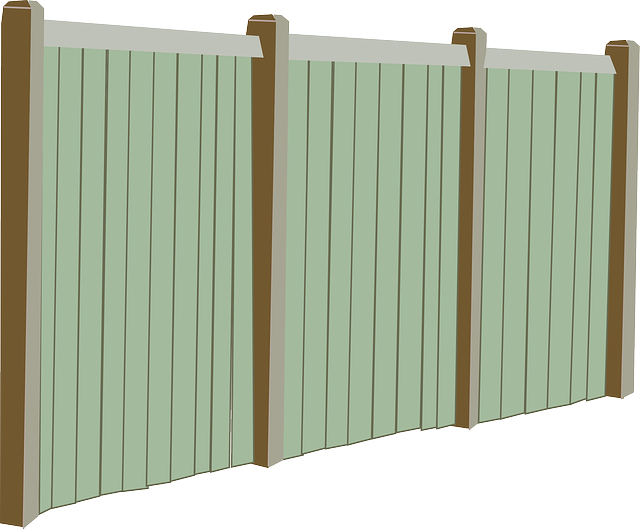In New Bedford, Massachusetts, enhancing your outdoor space with a wooden fence offers both aesthetic appeal and practical benefits. This comprehensive guide delves into the world of wooden fence installation services, equipping homeowners with invaluable insights. From understanding various styles and reaping the advantages of natural barriers to navigating local regulations, we cover it all. Whether you’re seeking privacy, security, or simply a visually pleasing addition, this article provides a step-by-step journey towards your perfect wooden fence.
- Understanding Wooden Fences: Styles and Benefits
- Choosing the Right Fence for Your Property
- Preparation: Site Assessment and Planning
- Installation Process: Step-by-Step Guide
- Post-Installation Care and Maintenance Tips
- Local Regulations and Permits for Fence Installation
Understanding Wooden Fences: Styles and Benefits
Wooden fences offer a classic aesthetic appeal with numerous styles to suit different preferences and property needs. From traditional picket fences to sturdy post-and-rail designs, each style provides both privacy and security. The versatility of wood allows for customization in terms of height, width, and intricate patterns, making it adaptable to any landscape. Moreover, wooden fences have environmental benefits; they are renewable resources that can be sustainably managed, contributing to a greener environment.
These fences provide numerous advantages beyond their visual appeal. They offer privacy, creating a sense of seclusion and security for homeowners. Wooden fences are also durable, capable of withstanding various weather conditions, and they can last for decades with proper maintenance. Additionally, they can increase property value by enhancing curb appeal and providing a secure outdoor space for families and pets.
Choosing the Right Fence for Your Property
When considering a wooden fence installation for your New Bedford property, choosing the right type is essential to enhance curb appeal and provide functional benefits. The first step is to evaluate your specific needs and preferences. Fences come in various styles, from traditional picket fences that offer a classic aesthetic to privacy fences ideal for blocking out views. Each has its unique charm and serves different purposes, so understanding your goals will help guide the selection process.
For instance, if privacy is a priority, opt for solid wooden panels or a more intricate design like a lattice fence. Consider the amount of maintenance you’re willing to undertake as well; some fences require regular painting or sealing to protect against the elements. Additionally, think about the fence’s location and any local regulations regarding height restrictions or permitted styles.
Preparation: Site Assessment and Planning
Before installing any wooden fence, a thorough site assessment and planning phase is crucial. This involves evaluating the land’s topography and identifying potential challenges like trees, utility lines, or existing structures that could impact the fence’s alignment and design. During this preparation stage, professionals also consider local regulations and property boundaries to ensure compliance.
Site preparation includes marking out the fence line, removing any obstructions, and ensuring proper drainage to prevent water damage. This meticulous planning guarantees that the final wooden fence not only looks aesthetically pleasing but also stands strong against the elements, providing both privacy and security for years to come.
Installation Process: Step-by-Step Guide
The installation process for a wooden fence begins with careful planning and preparation. First, our expert team surveys your property to understand the layout and specific needs. Based on this assessment, we create a detailed plan outlining the design, materials, and timeline. Next, we clear the area, marking out the exact locations of posts and panels. This ensures precise measurements and a solid foundation.
Our technicians then excavate holes for the fence posts, ensuring they meet the required depth and stability standards. The posts are installed using concrete, allowing them to set firmly in place. Following this, we attach the horizontal rails and vertical panels, securing them with robust fasteners. Finally, we finish the installation by adding any desired accessories, such as gates or latches, ensuring a secure and aesthetically pleasing fence.
Post-Installation Care and Maintenance Tips
After your wooden fence installation in New Bedford, Massachusetts, proper care and maintenance will ensure its longevity and beauty. Regular cleaning is essential to remove dirt, leaves, and debris, preventing buildup that can weaken the fence over time. Use a soft brush or garden hose for routine cleaning, and consider a mild detergent for stubborn stains.
Inspect your fence at least twice a year for any signs of damage, rot, or insect infestation. Promptly repair or replace any damaged sections to maintain structural integrity. Apply fresh coats of sealant every few years to protect the wood from harsh weather conditions, UV rays, and moisture, ensuring the fence remains vibrant and well-maintained for many years to come.
Local Regulations and Permits for Fence Installation
When planning to install a wooden fence in New Bedford, Massachusetts, understanding local regulations and permit requirements is essential. Each municipality has its own set of guidelines that homeowners and contractors must adhere to, ensuring compliance with zoning laws, property lines, and safety standards. Failure to obtain the necessary permits before beginning construction can result in fines or even the halt of your project.
In New Bedford, any structural changes to a property, including fence installations, often require permits from the Building Department. These permits ensure that the fence meets specific height, design, and material standards. Homeowners should review the local building codes and consult with their contractor to determine if a permit is necessary for their specific project. It’s always best to check with the New Bedford Building Department or relevant authority to stay informed about any updates or changes in regulations.
